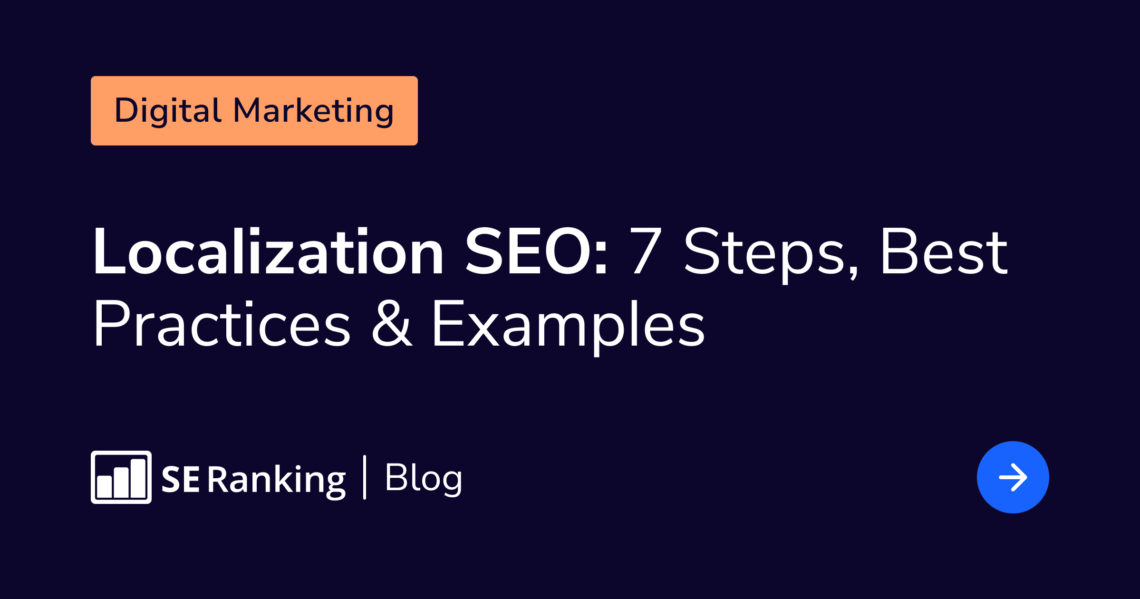- Key Takeaways
- Why Go Global and Localize?
- SEO Translation vs SEO Localization: What’s the Difference?
- What Do You Need to Localize?
- 7 Steps & Best Practices for Building Your SEO Localization Strategy
- 1. Prepare your site’s URL structure
- 2. Find your local search competitors
- 3. Identify relevant keywords
- 4. Build your keyword map
- 5. Use keywords in content and scale
- 6. Localize keyword position tracking
- 7. Track market conversion sources and types
- Before You Get Started: How to Build an SEO Forecast for the New Market
- Example: Complex B2B SEO-Generated Revenue Forecast
- One Final Piece of Advice
Every culture is different, and every market is unique. That is why as a digital marketer or SEO specialist, you can’t assume that strategies effective in one country will guarantee success in another.
Localization SEO bridges this gap. It helps you understand and adapt to the local search habits and nuances of each target audience. It focuses on connecting with people on a cultural level, understanding their pain points, and speaking their language (literally and figuratively!) while attracting qualified traffic.
This blog post will equip you with actionable steps, best practices, and examples to help you build your SEO localization strategy. Following these techniques will bring you closer to attracting customers worldwide and dominating the SERPs in your preferred locations.
Key Takeaways
- Go global to expand your business, reach new audiences, and diversify your revenue.
- Prioritize localization over translation. SEO localization creates a culturally relevant, search-optimized experience centered around local search habits, keyword intent, and messaging.
- Build an effective SEO localization strategy by:
- Choosing the right site’s URL structure
- Identifying your local search competitors
- Researching local keywords
- Building market-specific keyword maps
- Optimizing content for target keywords
- Setting up localized keyword position tracking
- Tracking conversion sources and types
- Forecast the new market’s SEO potential to set realistic KPIs.
- Review your strategy every 3 to 6 months. Avoid impulsive changes and focus on long-term performance data.
Why Go Global and Localize?
The internet has shrunk the world. Reaching a global audience has never been easier for businesses. International marketing has become the new normal, especially because it gives you greater potential to fuel growth and profitability in new markets. Here’s why it is so popular:
- Revenue diversity increases company sustainability
Diversifying into multiple markets helps companies avoid putting “all their eggs in one basket.” This is especially critical given rapidly changing customer expectations, technology, and economic conditions resulting from global misfortunes like COVID and recent recessions. Selling in multiple countries provides companies with better protection against market-specific challenges. Generating revenue from different parts of the world makes businesses stronger and more flexible when facing challenges in any single market.
- Today’s customers expect a personal approach
Having an English-only website used to be considered a viable form of “international marketing”. Not anymore. Customers now expect (and deserve) a much more personalized approach.
The world is full of amazing cultures and languages, each with specific regional dialects and cultural nuances. For example, Germany, there exists Bavarian, as well as the Dutch region’s German-speaking area, Swiss German, and Austrian German. There are also various sub-regional dialects and forms of expression. This is why it isn’t enough to simply translate your website.
Effective localization requires understanding and adapting to the nuanced linguistic differences within markets. It allows you to speak to your customers from their cultural (or regional) perspective.
- Provides you with a unique advantage over competitors
Tailoring your marketing to different countries goes beyond meeting minimum expectations. Doing it right gives you a big competitive advantage.
Many companies don’t do a great job at this. This suggests that you can make yourself stand out and impress local audiences by mastering your international marketing for each culture. The trick is to engage with your customers by considering their cultural nuances and search habits. This will make you the obvious choice over your rivals because your target audience will feel a stronger connection to your brand.
SEO localization also increases the chances that established websites from your target region will link to your content naturally. This means you get more high-quality backlinks, which work to boost your site’s authority and trustworthiness.
Side note: When building backlinks for international markets, opt for a digital PR approach instead of traditional outreach or paid links. Collaborate with respected websites in your target regions by creating guest content, webinars, and co-marketing content.
This is a double win because:
- It gives you high-quality backlinks. This is much better than paid link building, which can even be considered spam. Backlinks built through collaboration are natural and trusted by search engines.
- This also gives you the potential to boost your brand awareness and generate leads.
Overall, the best approach is to align your link building with your PR strategy for each market. Strategically target a select few impactful placements, and avoid accumulating heaps of low-quality links. This approach is more efficient and cost-effective, and helps you truly connect with your target audience.
SEO Translation vs SEO Localization: What’s the Difference?
Translation and localization are often used interchangeably, but they are different concepts entirely. They also have different use cases, chief among them is when doing SEO on your website. Take a look at the table below to see their key differences.
Supports basic communication across languages.
Localization for SEO
(recommended 👍)
Creates a culturally relevant experience that is search-optimized for the target audience.
Translates your website content from one language to another, often using machine translation.
Localization for SEO
(recommended 👍)
Adapts content and website elements for specific markets, including headings, URL, metadata and content.
Doesn’t consider local search habits or keyword relevance.
Localization for SEO
(recommended 👍)
Considers search volume and user intent when optimizing content for local keywords.
Direct translation without considering local tone of voice or cultural nuances.
Localization for SEO
(recommended 👍)
Matches content to the correct tone of voice and adapts it to local messaging guidelines.
May not be adapted to the target language.
Localization for SEO
(recommended 👍)
Ensures correct implementation of SEO settings for multilingual site versions.
Supports basic communication across languages.
Creates a culturally relevant experience that is search-optimized for the target audience.
Translates your website content from one language to another, often using machine translation.
Adapts content and website elements for specific markets, including headings, URL, metadata and content.
Doesn’t consider local search habits or keyword relevance.
Considers search volume and user intent when optimizing content for local keywords.
Direct translation without considering local tone of voice or cultural nuances.
Matches content to the correct tone of voice and adapts it to local messaging guidelines.
May not be adapted to the target language.
Ensures correct implementation of SEO settings for multilingual site versions.
SEO translation converts website content from one language to another, often using machine translation tools or basic human translation. Even if reviewed by a person, translated content can’t always capture the full nuances of the marketing strategy or local language usage.
Kind reminder: Directly translating keywords and content often has little to no impact on SEO performance. Many companies seeking help with international SEO have websites with decent-quality translations. The issue is that they see virtually no traffic from the target market due to improperly addressing the SEO localization aspect.
SEO localization optimizes your website in each market, specifically for search engines and cultural relevance. This leads to better traffic and conversions.
To demonstrate the difference, here is an example.
Let’s say you’re selling sports shoes in the UK but also want to target the German market. You must translate your page title “Sports Shoes for Sale” directly to German.
- German translation: The direct translation would be “Sportschuhe zum Verkauf” which is technically correct, but not how Germans typically refer to cheap sports footwear.
- German localization: Deep research into German search habits reveals that Germans might use terms like “Sportschuhe kaufen” (buy sports shoes) or “günstige Sportschuhe” (cheap sports shoes) when searching for deals. Plus, while “Sportschuhe kaufen” is widely used, some southern regions might prefer terms like “Turnschuhe kaufen” (buy sneakers).
The key takeaway: Simple translation is not an option if you want to drive substantial growth through your international SEO efforts. You must go one step further by fully localizing your SEO strategy for each market. Putting in this extra effort is critical for success when expanding to new countries.
What Do You Need to Localize?
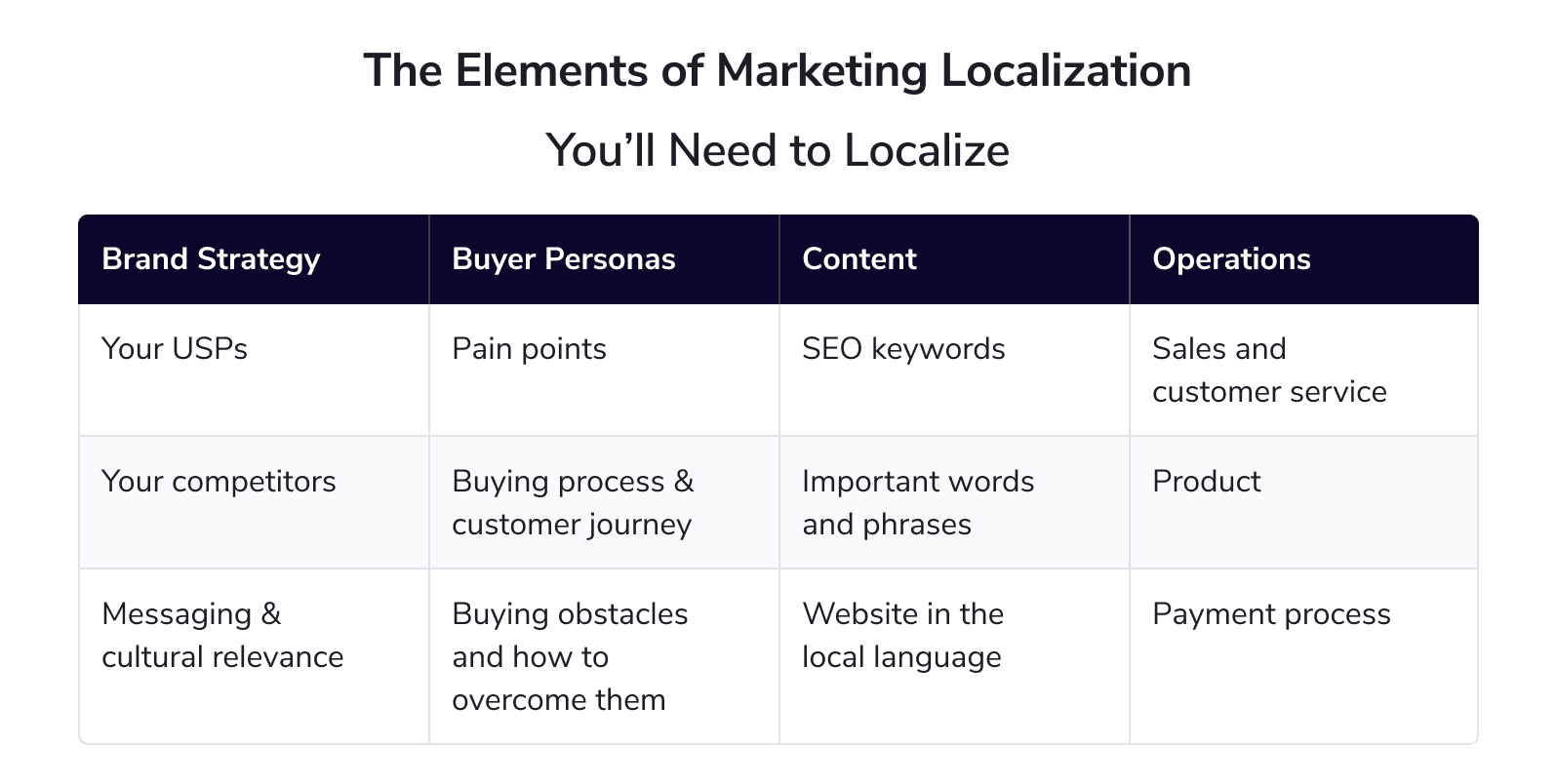

SEO localization is very humanistic in scope. It goes beyond translating words (like machines do) and translates meaning. Succeeding with a good ROI necessitates adapting your business to each country’s unique needs. Let’s look at each aspect of your marketing and business that requires localizing.
- Brand Strategy. Your USPs, positioning, competitors, messaging and cultural relevance will differ. These elements must be carefully adapted because what makes you special and the characteristics of your buyer personas will vary from country to country.
- Buyer Personas. Your buyer personas need to be recreated too. People in the EU will have different problems, product preferences, and buying habits than people in the UK or other parts of the world. Their needs, wants, and pain points will vary.
- Content. You must update all of your content and marketing messages for each audience. This goes beyond simple translation; you’ll need to adapt your website content for local audiences to fit their interests, cultural preferences, metaphors, idioms, and even humor.
- Operations. International expansion requires an operational shift to generate ROI, necessitating you adapt your sales process, customer service, products and payment options. For example, Germans prefer bank transfers or cash payments over PayPal or credit cards. If you only offer the latter, you can lose a lot of potential German customers.
The key takeaway is to localize holistically. Personalizing every customer touchpoint for its designated market improves the success rate of your localized SEO. The conversions you generate will turn into actual leads and sales because the whole journey will be seamless.
7 Steps & Best Practices for Building Your SEO Localization Strategy
1. Prepare your site’s URL structure
Before localizing your content to a new language, fix your site’s URL structure. Here are the three primary ways to do it and their SEO pros and cons:
Option 1: Subdirectories (example.com/de)
- Pros: This is the best option because it preserves your existing website’s authority. Google sees the content in the subdirectory as part of your main site.
- Cons: Managing a subdirectory structure can be slightly more complex than separate domains, especially if you need to make major customizations for each market.
Option 2: Subdomain with gTLD (de.example.com)
- Pros: This is a separate subsect within your main domain. This method can work if your CMS (like HubSpot) only allows subdomains. Just expect it to take longer to rank new content.
- Cons: This option is not ideal because Google treats subdomains as newer versions or subversions, meaning they have less authority than the main domain. This can make ranking well in your new market more difficult at first. Plus, the URL (de.example.com) might not be clear to all users (is it Germany or German?).
Option 3: New domain (example.de)
- Pros: This option is ideal if there is no good way to get your CMS and localization to work together on subdirectories or subdomains.
- Cons: This is the least SEO-friendly option. New domains have zero authority, making it an uphill battle to rank well. Building up SEO will take more time.
Bonus Tip: Avoid these common traps:
- Adding only a language tag after your root domain (like .com/en). Google can’t understand this and won’t be able to discern the website’s intended language.
- Having no clear “home” for each language. Having content mixed and jumbled together confuses Google.
- Using an automatic Google Translate plugin that doesn’t change the URL when you switch languages. This also harms your main language’s SEO.
- Forgetting to geo-target your site on a page level. The correct course of action is to use hreflang or sitemaps to inform Google which pages apply to which locations or languages.
Explore Google’s resources on locale-specific URLs to learn more about URL structures.
Consider this: GA Agency partnered with SE Ranking to analyze over 20,000 keywords across 15 countries. The team discovered which website structure was the most common. Read this article on subdomains and subdirectories to explore research-based findings and inform your localization SEO strategy.
2. Find your local search competitors
Knowing who you’re competing against is crucial in SEO. It is even more crucial when going global. Here is how to find your local SEO competitors in a new market:
- Distinguish local SEO competitors. When trying to grow in a new country, you need to know who your local search competitors are. They may differ from your usual business or product competitors. Even if you sell the same product or service or have the same type of offer as them, your local competitors may not be doing SEO at all. While they still technically count as a competitor for you, the only one doing the ‘competing’ is you.
- Look at who your local search competitors are. Find out who is actually showing up in that specific market for the primary keywords you want to rank for. The easiest way to verify this is by checking what Google displays in local search results.
One free tool that is great for this is SE Ranking’s Google Location Changer. It lets you check your SERPs for any keyword, country, language, or location.
- Search like a local. Use relevant keywords. Focus on bottom-of-the-funnel terms that potential customers would use when ready to make a purchase. Don’t worry about having the exact localized phrase yet. You can still see who shows up and get clues about their local search habits.
- Learn from the rankings. Analyze the top search results.
This can reveal interesting insights into:
- How competitors structure their content for the local language.
- The actual keywords they’re targeting.
- Even interesting nuances, like using English phrases within German descriptions (as seen in the example below).
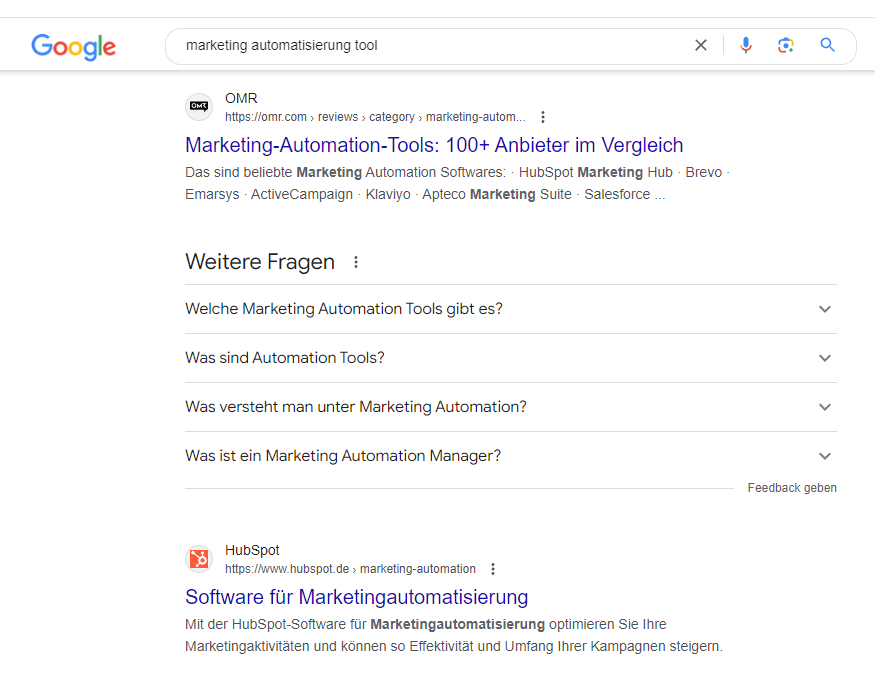

As you can see, the top organic result’s description includes both the English phrase and the German translation. This is a common occurrence. These little quirks and nuances happen in every market.
Bonus tip: Prioritize the local language first. If results are lacking, consider a mix based on audience research.
Remember:
- User preferences can change over time, so stay vigilant.
- There’s no one-size-fits-all solution. Research is key!
- Don’t be afraid to experiment. Test what resonates best with your audience.
- It’s okay if you don’t have all the answers right away. The important thing is to keep learning and modifying your approach.
3. Identify relevant keywords
Now that you have identified your competitors, you can start researching the keywords that lead to conversions:
- Focus on long-tail keywords.
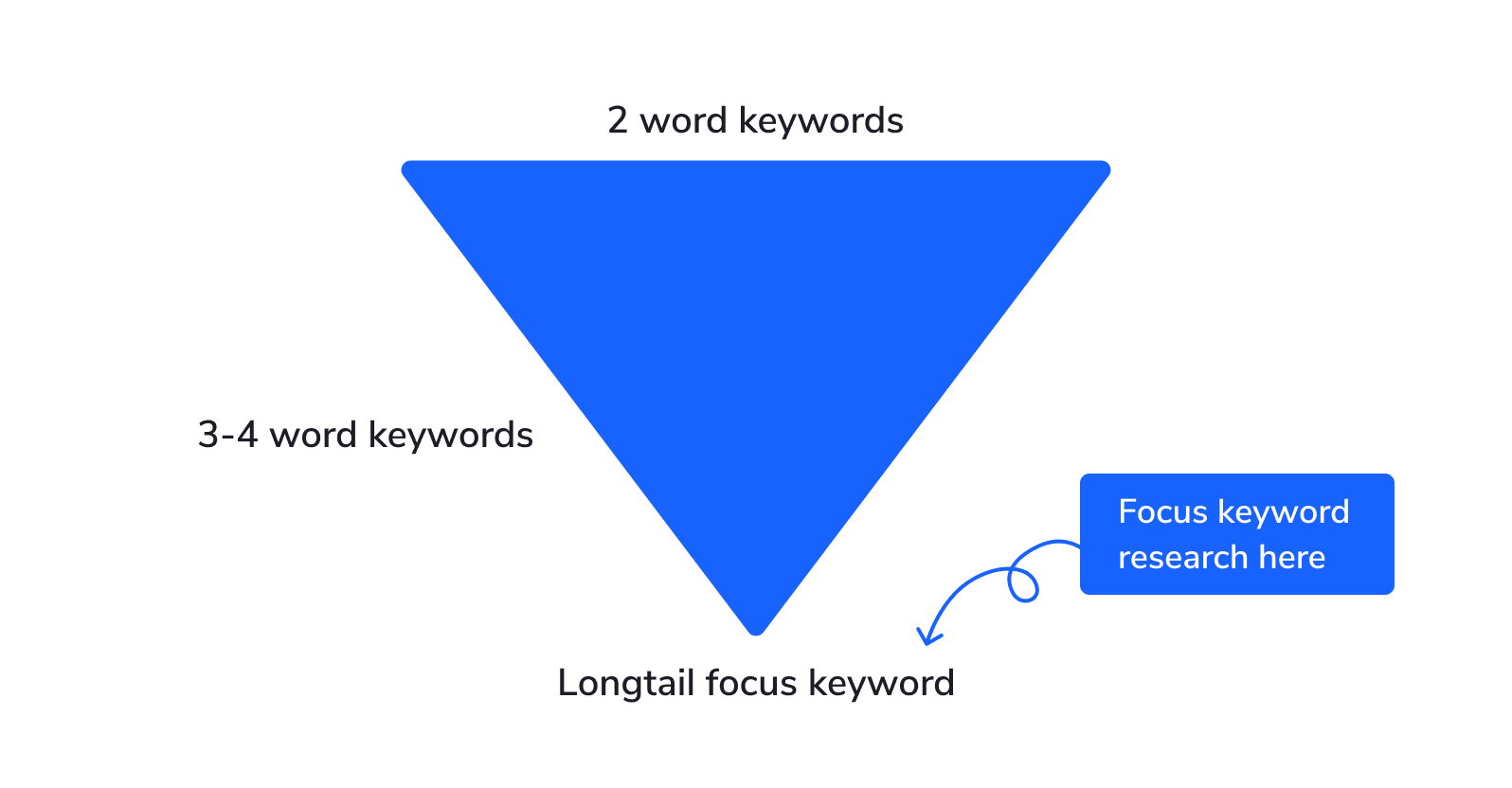

Regardless of language, SEO thrives on long-tail keywords, which are detailed phrases with 3+ words that describe your product or service and have clear search intents. Long-tail keywords have higher conversion rates because they are typically used by users who are closer to making purchase decisions. If you haven’t yet pinpointed the exact phrasing, begin with a translated version of your keywords. This is a good starting point.
Tools like SE Ranking’s Keyword Suggestion Tool help with collecting similar and related terms. You can use them to refine these phrases based on actual search volume and user intent.
- Pay attention to search volumes. This data provides insights into how people typically phrase their queries. If you notice a particular phrasing taking on the highest search volume, it is likely the most common and effective way to reference your product or service in that language.
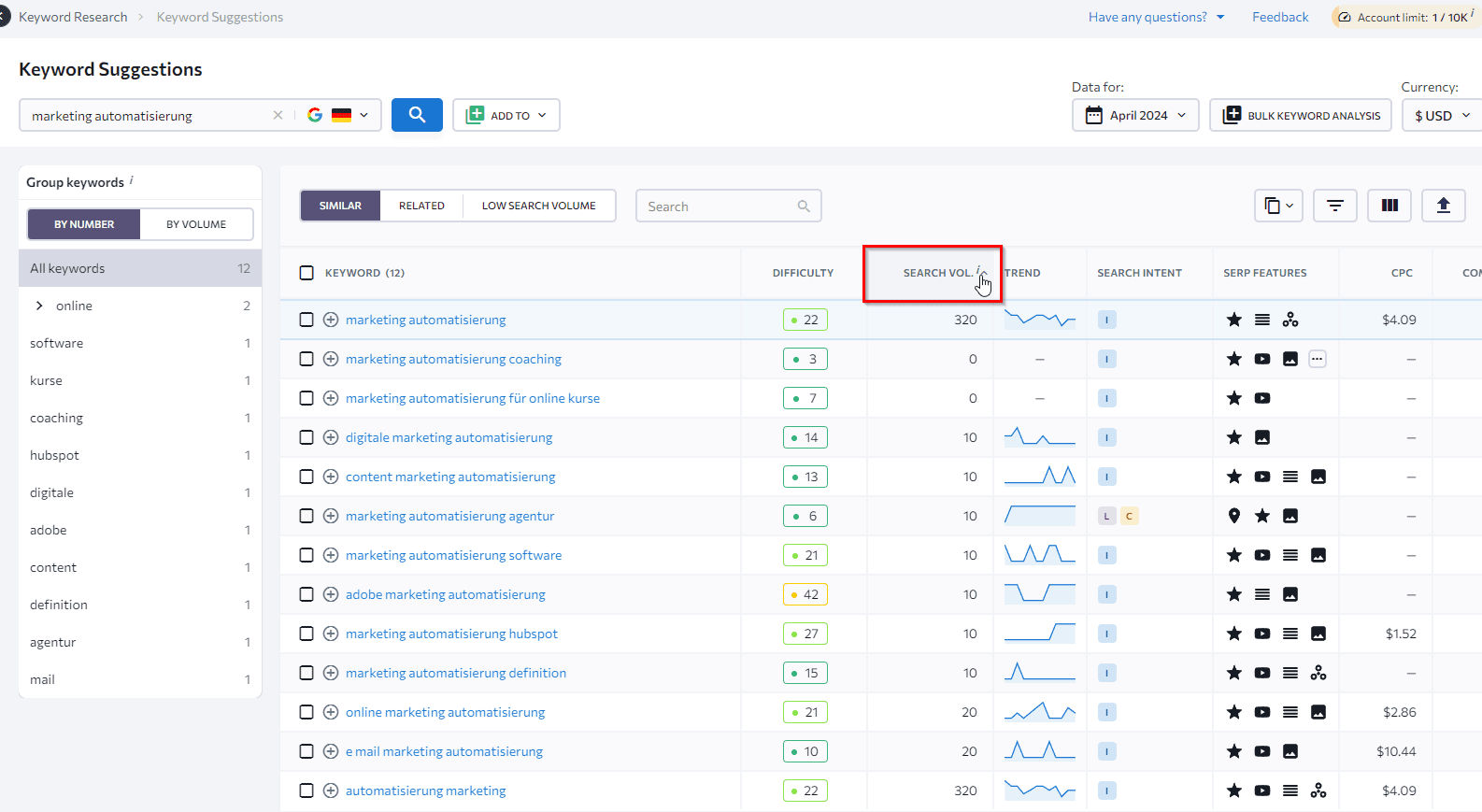

- Partner with a local SEO strategist. Local experts speak the language and understand the cultural nuances. Use their insights to guide your keyword research and understand the nuances of local search habits.
4. Build your keyword map
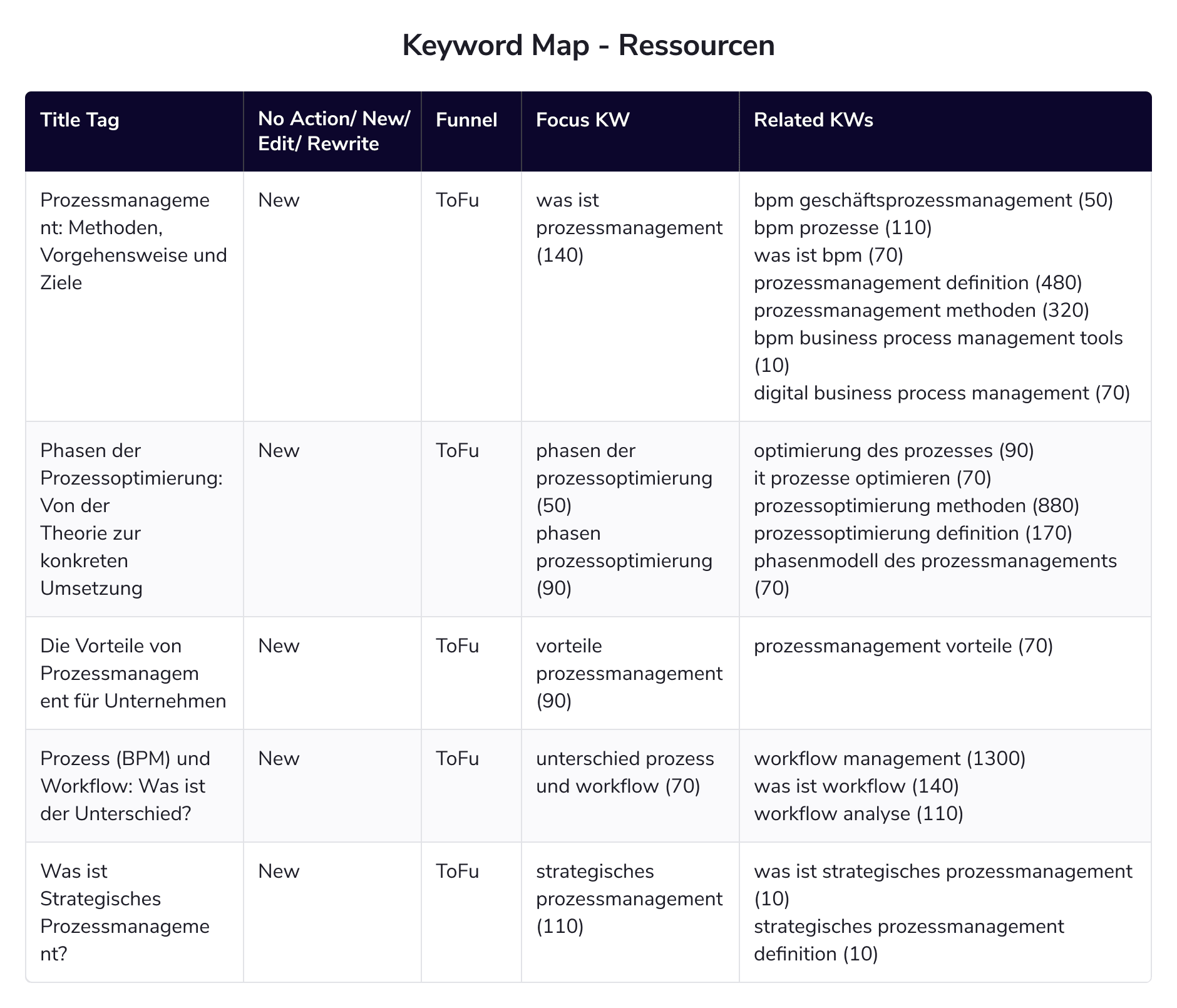

Resist the urge to simply translate your existing keyword map and content strategy. Conduct fresh keyword research for each new market, as search behavior and language nuances can vary significantly across languages and cultures.
To build your keyword map for a new market, follow a process similar to what you would do in your native language:
- Categorize keywords by intent and search volume. Variances in user search intent, demand, and phrasing depend on language and culture. We have also determined through our practical experience that blind translation does not work.
Informational keyword localization example: Imagine you need to localize a blog about “what is process management” from English to German to reach your audience in Germany.
what is process management
was ist prozessmanagement
prozessmanagement definition (process management definition)
what is process management
was ist prozessmanagement
prozessmanagement definition (process management definition)
As you can see, the most natural-sounding translation of a keyword may not be the most commonly searched version. In the example given, “process management definition” has a much higher search volume in German than the direct translation of “what is process management.”
It’s also important to determine the search intent and if it is the same in both markets. For example, in the German market, many transactional phrases in English are actually informational phrases in German. So, it would be ineffective to translate an English transactional landing page into German if Germans are actually searching for informational content on that topic.
The lesson here: Identify keywords in the local language with matching search intent to the non-native keyword.
Transactional keyword localization example: Let’s say a company based in the US has a popular “heated tobacco” product. They plan to use an SEO-driven approach to expand into Hungary.
fűtött dohány (heated tobacco)
“dohányhevítő” (tobacco heater)
fűtött dohány (heated tobacco)
“dohányhevítő” (tobacco heater)
Translating directly yields zero search volume. Localized research reveals “tobacco heater” is the preferred term, with even higher search volume than the US market. This indicates a receptive market.
The lesson here: Check local keyword search volume and consider similar phrases.
- Group related keywords into clusters. Group related keywords with similar intent (informational vs. transactional) into clusters (e.g., with informational intent “process management definition,” “process management meaning,” “process management explanation”). This helps you structure your content effectively.
- Focus on keyword clusters with high search volume (those most likely to lead to sales or signups) and ones that closely match your existing content from your home market. These will be easier to localize and will save you time and resources.
- Map content to keyword clusters. Build your content strategy around keyword clusters. Determine each cluster’s appropriate content type (informational, transactional, etc.) based on search intent.
Remember:
- Search intent and phrasing: Learn about how your target audience phrases their searches.
- Grammar matters: Google understands synonyms and alternative phrasings, but always keep your content grammatically correct for a better user experience.
5. Use keywords in content and scale
Now that your keyword map and content topics are ready, you can start creating content that targets your chosen keywords for better reach. Here are some major things to consider when using keywords in your content and scaling your efforts:
SEO Title: Focus Keyword Here l Brand Name (60 characters, may be reduced length from H1 but should be a close match)
SEO Description: Focus keyword at the start and CTA at the end. (150 characters)
URL: /language-subdirectory/longtail-focus-keyword
(H1) Title of the content
Introduction
- Bullet point notes on what the content writer could write in the introduction
- Use the focus keyword at the beginning.
(H2) Subheading
SEO Title and SEO Description:
- Incorporate your focus keyword or a close variation of it in the title.
- Although Google now changes between 60% and 80% of titles and meta descriptions on SERPs, you should still create accurate summaries that reflect the content. Avoid misleading summaries that hurt click-through rates (CTR).
URL Structure:
- Use the appropriate language subdirectory (e.g., /de/ for German) in your URL structure.
- Include the localized focus keyword in the URL slug.
- Google passes through links to crawl content, so mixed languages in URLs will confuse Google’s crawlers. It’s better to maintain consistent language in both your content and URLs. A clear URL structure helps search engines understand your content and connect it with the right audience.
Keyword usage:
Weave your target keywords naturally into your content’s SEO titles, descriptions, subheadings, and body text. Avoid keyword stuffing; think about your users instead.
6. Localize keyword position tracking
Localizing keyword position tracking is crucial for understanding your performance in different markets and languages. This process is closely tied to your site structure, as you need to track your position based on your site structure, specifically where each market’s home and language are located. Here’s how to approach localized keyword position tracking:
- Don’t track keywords for all languages together. Instead, your site structure should reflect separate language versions. This enables you to track keywords for each market individually, providing precise data on the performance of your content in each location.
You can use SE Ranking’s Rank Tracker tool to track location-specific groups of keywords for each market separately. To add search engines or specific locations and languages, go to the Project Settings, specify the desired parameters for a particular search engine, and click on the Add search engine button.
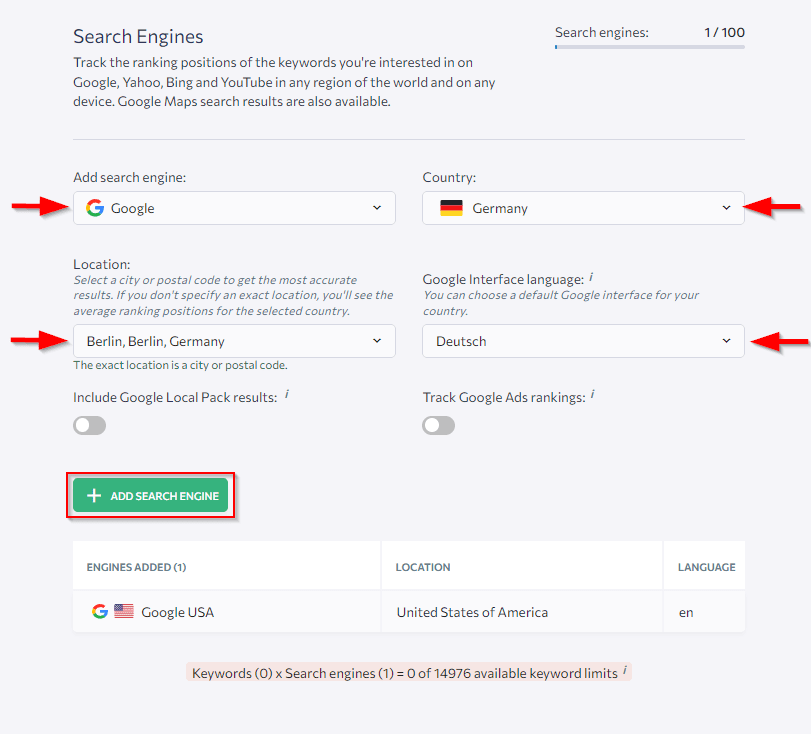

Now you can go to the Rankings tab. Change the locations as needed from the dropdown list.
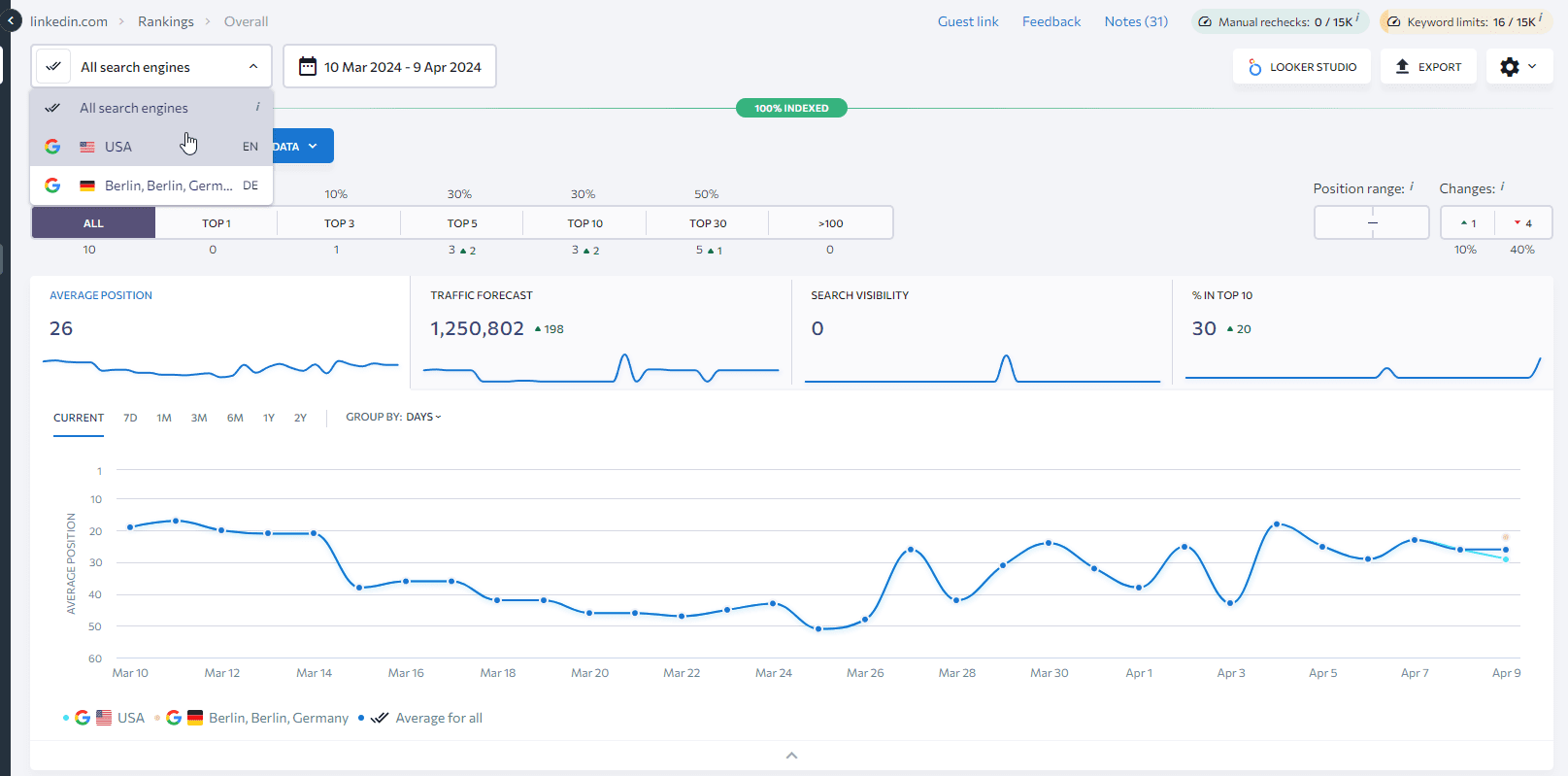

- When dealing with multiple markets and languages, you need to monitor each market’s keyword positions on top of its content engagement and conversion metrics. This can be done using tools like Google Search Console (for tracking SERP impressions and clicks) and Google Analytics (for setting up separate conversion tracking for each market). Analyzing these metrics enables you to identify improvement areas in your content and find ways to allocate your resources accordingly.
- Monitoring performance across languages provides valuable insights. For example, maybe one market is underperforming whereas another is outperforming. In situations like these, you can adjust your efforts accordingly, either by reducing your efforts in the underperforming market or doubling down on the successful one.
7. Track market conversion sources and types
Traditional SEO metrics often focus on rankings and traffic, but you need to explore further to succeed in local SEO. Here’s how to master market-specific conversion tracking:
- Conversion tracking by market: Set up separate conversion tracking for each market. Track beyond surface-level conversions and discover the source of those conversions (organic traffic, paid ads, social media, etc.). This gives you a comprehensive view of how your SEO efforts are influencing conversions in each specific region.
- Conversion types: Track various conversion types relevant to your business.
- In ecommerce, this could include submissions or purchases.
- In B2B, this could include demo bookings, event registrations, or form submissions.
Granular data like this reveals which content types and SEO strategies are most effective at generating leads and sales for each market.
- Attribution and stakeholder buy-in: With detailed conversion tracking, you can attribute sales directly to your SEO efforts. It gives you a birds-eye view of how content at different stages of the buyer’s journey (Tofu (Top-of-funnel), MoFu (Middle-of-funnel), and BoFu (Bottom-of-funnel)) leads to conversions within each market.
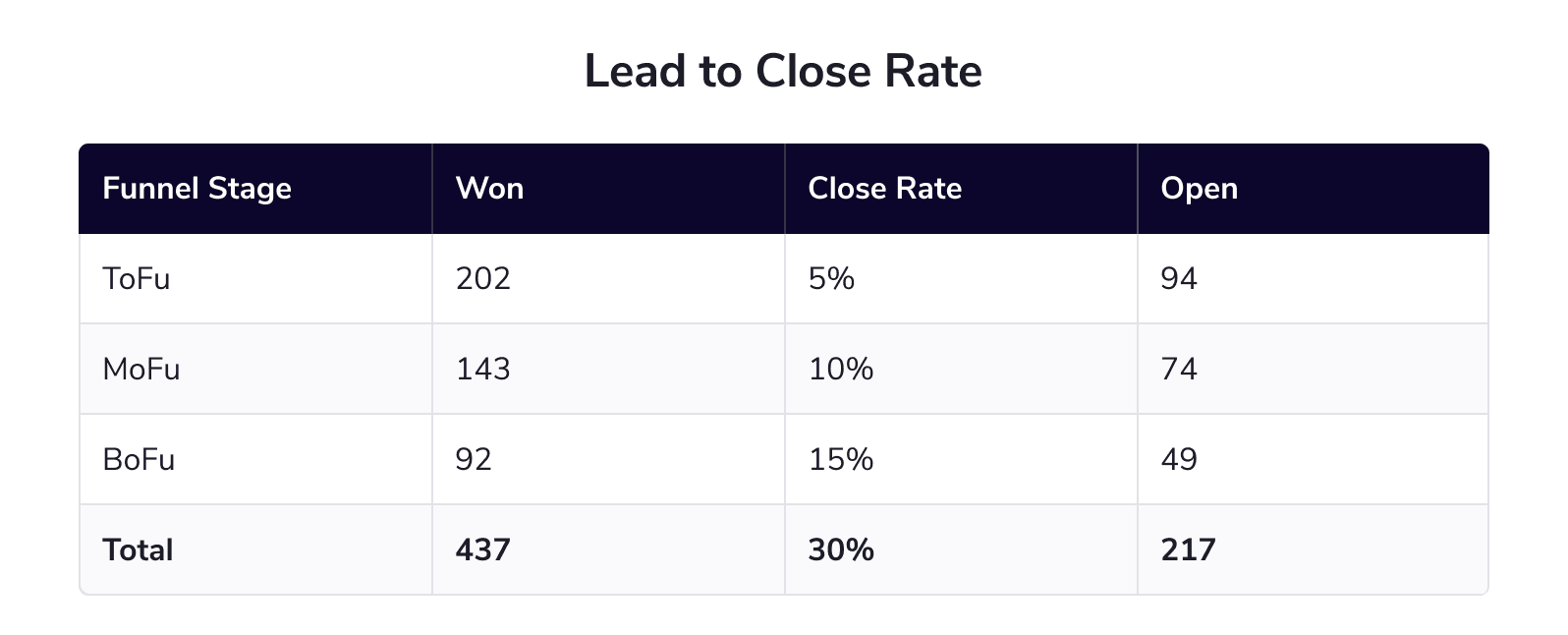

This makes it easy to see how many leads or sales are generated from each content type. It also provides clear data to convince stakeholders of the value of your SEO work.
- Use tools like Google Analytics 4 (GA4) to track conversions by content type, source, and market. Combine this with event tracking to connect specific user actions to conversions occurring within your business.
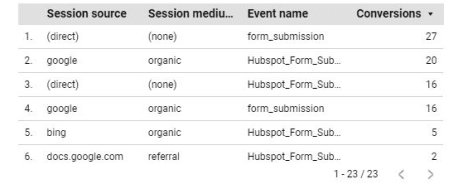

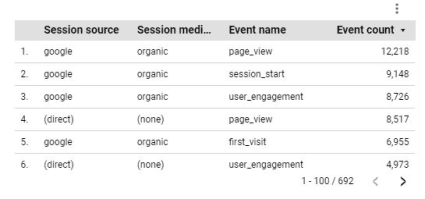

Before You Get Started: How to Build an SEO Forecast for the New Market
Just having an understanding of how local SEO works isn’t enough. You also need to be realistic about each market. One major factor to consider when evaluating a new market is how much potential it actually has for your product or service.
To create an effective SEO forecast, consider the following:
- Potential traffic: Estimate the amount of organic traffic you have the potential to attract based on relevant keywords and their search volumes in the new market.
- Competition: Analyze the competitive landscape in the new market, including the strength of competitors’ SEO strategies and their domain authority.
- Seasonality: Consider seasonal changes in search demand for your offerings in the new market.
- Conversion and revenue potential: Estimate the conversion rate and average order value (or contract value) in the new market to gauge potential SEO revenue.
Read this in-depth guide on SEO forecasting for more details.
Example: Complex B2B SEO-Generated Revenue Forecast
B2B forecasting can be more complex and often involves more than just direct sales. One approach is to set a traffic milestone. For example, maybe your client already has an established SEO strategy and high search demand for their product. Your goal might then be to initiate a 30% traffic increase over six months.
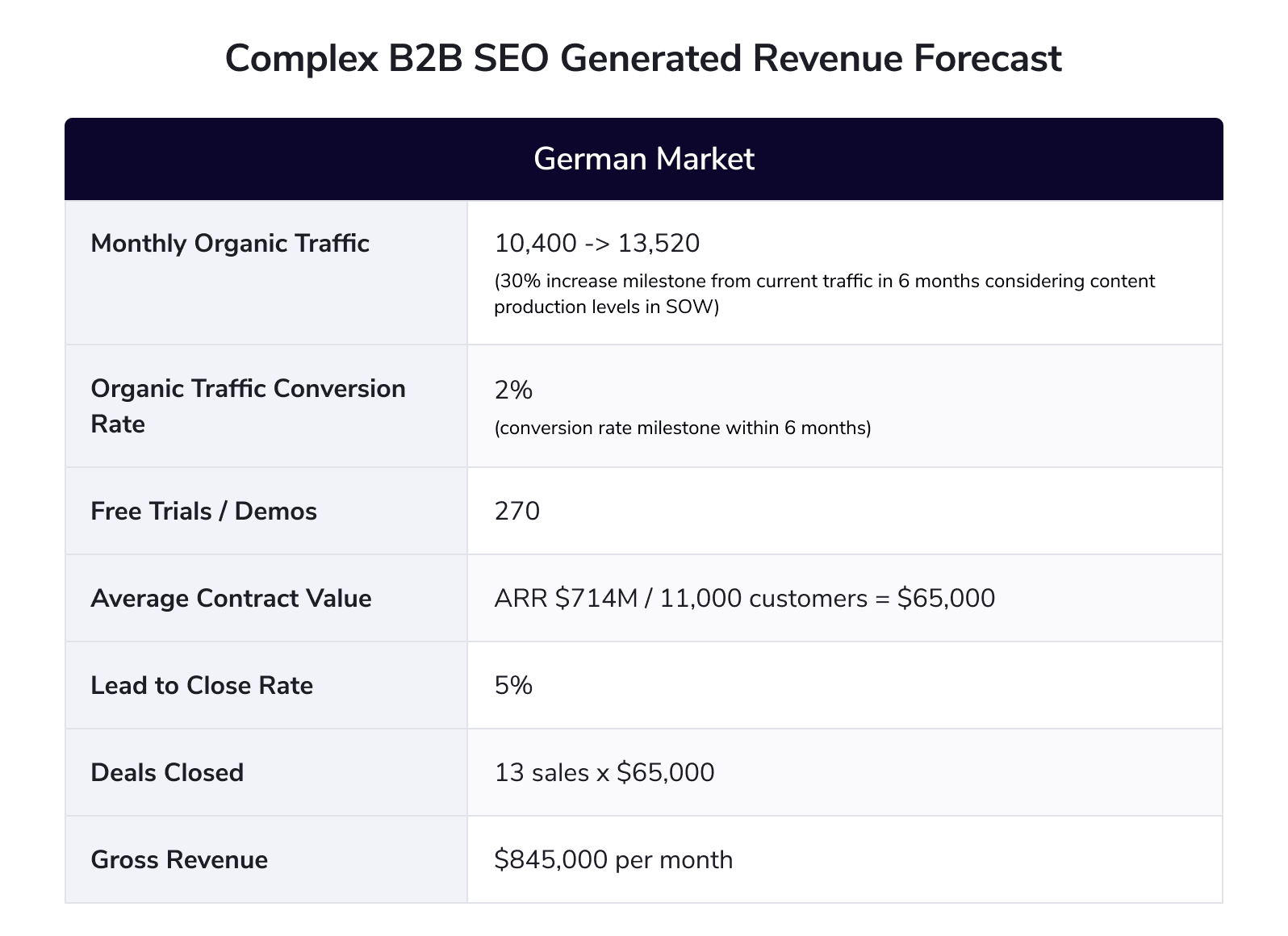

This milestone helps you estimate the revenue generated from SEO. If you produce a specific amount of content and increase traffic by 30%, you can calculate the number of free trials or demos generated using your conversion rate. Then, you can estimate the average contract value and the number of leads typically converted to forecast potential revenue.
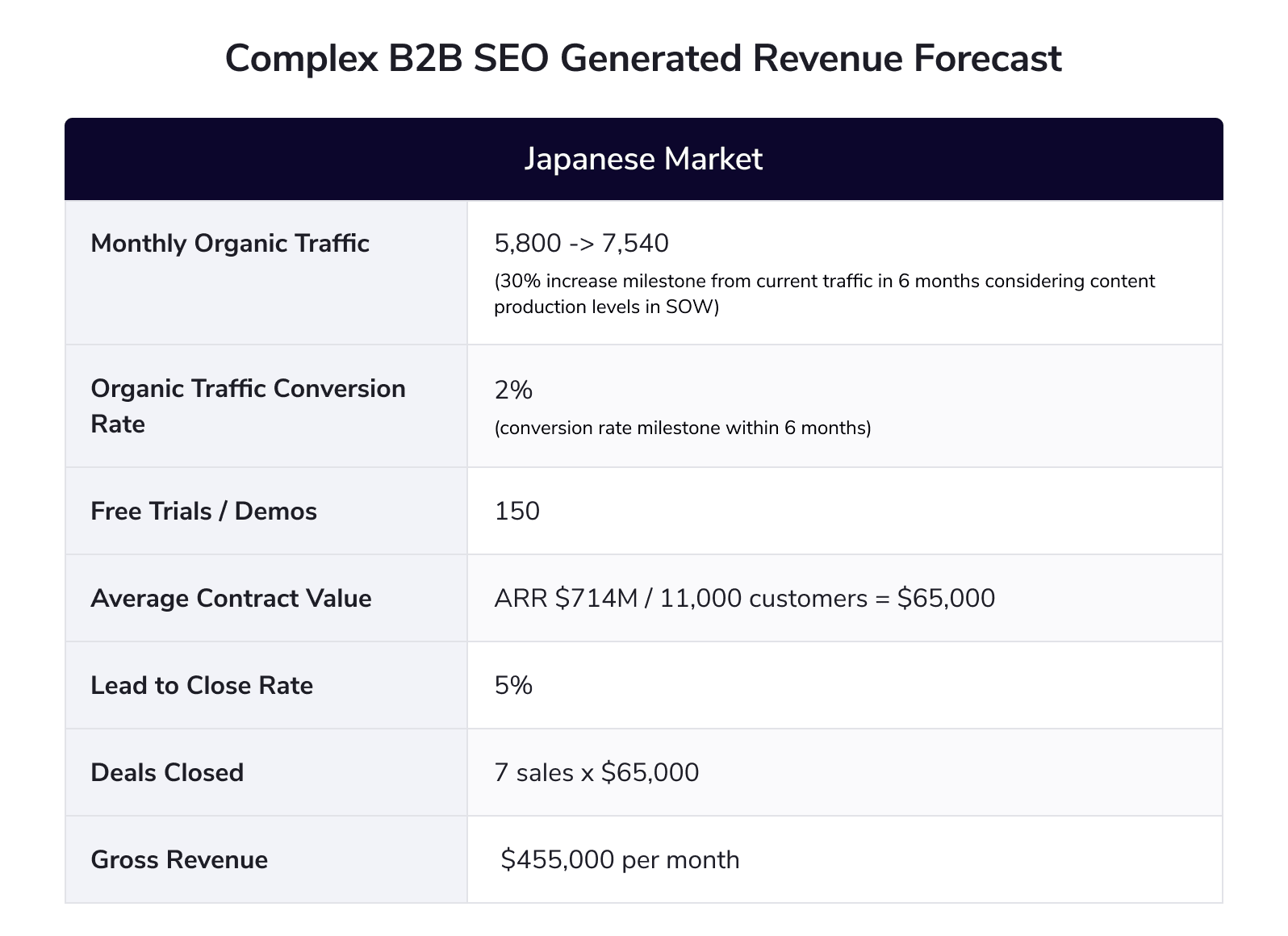

It’s also important to consider each market’s size and unique characteristics. In our example, you can see that the Japanese market is typically smaller than the German market, but this can vary. The Japanese market market may even outperform in other product categories, like electronics. When forecasting for Japan, you would need to adjust your expectations and KPIs accordingly while also considering factors like population size and market maturity.
**While this approach is peppered with assumptions and requires input from teams beyond SEO, it helps illustrate the value proposition of SEO.**
Bonus Tip: When setting KPIs for a new market, don’t rely on benchmarks from your home market. Your home market is likely to be more successful due to factors like longer establishment and greater brand awareness. Set realistic KPIs based on the context of the new market to avoid disappointment.
One Final Piece of Advice
To properly adjust your localization SEO strategy and stay relevant in various markets, a good rule of thumb is to review your approach every 3-6 months. Be careful not to make changes too often or to panic when faced with SERP volatility or algorithm updates.
Instead, focus on monitoring your rankings and performance data over time. If a page consistently ranks in the top 5, it’s probably doing well. But if it drops to position 30 or lower and remains there for months, it’s time for optimization. Best of luck on your international journey!
منبع: https://seranking.com/blog/seo-localization/
